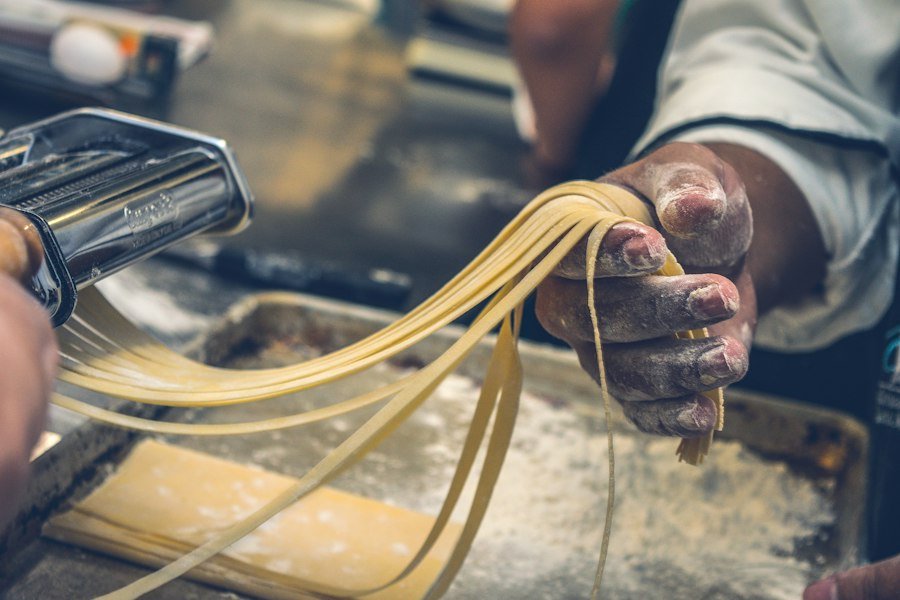

How to Talk About Cooking in Spanish: 25 Culinary Terms
Learning Spanish culinary terms is essential for anyone interested in cooking or exploring the world of Spanish cuisine. Spanish cuisine is known for its rich flavors, diverse ingredients, and unique cooking techniques. By understanding the language used in the kitchen, you can better navigate recipes, communicate with Spanish-speaking chefs and cooks, and fully appreciate the culinary traditions of Spain.
Spanish cuisine has had a significant influence on global cuisine. The exploration and colonization of the Americas by Spain in the 15th and 16th centuries brought new ingredients such as tomatoes, potatoes, corn, and chocolate to Europe. These ingredients quickly became staples in Spanish cuisine and were later adopted by other countries around the world. Additionally, Spanish cooking techniques, such as sautéing, frying, and grilling, have become fundamental techniques used in kitchens worldwide.
Table of Contents
ToggleKey Takeaways
- Spanish culinary terms are essential for understanding and communicating about Spanish cuisine.
- Basic cooking vocabulary in Spanish includes verbs like cocinar (to cook) and cortar (to cut).
- Essential ingredients in Spanish cuisine include chorizo, saffron, and paprika.
- Cooking techniques in Spanish include asar (to roast) and freír (to fry).
- Spanish words for kitchen utensils and appliances include cuchillo (knife) and horno (oven).
Basic Cooking Vocabulary in Spanish
To start your journey into Spanish culinary terms, it’s important to familiarize yourself with basic cooking vocabulary. Here are some common verbs used in cooking:
– Cocinar: to cook
– Freír: to fry
– Asar: to roast
– Hervir: to boil
– Hornear: to bake
– Mezclar: to mix
– Picar: to chop
– Batir: to beat
In addition to verbs, it’s also helpful to know the names of kitchen tools and equipment:
– Cuchillo: knife
– Sartén: frying pan
– Olla: pot
– Cacerola: saucepan
– Espátula: spatula
– Batidora: blender
– Colador: strainer
– Horno: oven
When it comes to measurement units in Spanish, here are some common ones:
– Taza: cup
– Cucharada: tablespoon
– Cucharadita: teaspoon
– Gramo: gram
– Litro: liter
– Kilogramo: kilogram
Essential Ingredients in Spanish Cuisine
Spanish cuisine is known for its use of fresh, high-quality ingredients. Here are some common ingredients used in Spanish cooking:
– Aceite de oliva: olive oil
– Ajo: garlic
– Cebolla: onion
– Tomate: tomato
– Pimiento: bell pepper
– Patata: potato
– Arroz: rice
– Jamón: ham
These ingredients play a crucial role in Spanish cuisine, adding depth of flavor and creating the foundation for many traditional dishes. Olive oil, for example, is a staple in Spanish cooking and is used for sautéing, frying, and dressing salads. Garlic and onion are often used as aromatics to enhance the flavor of dishes, while tomatoes and bell peppers are key ingredients in dishes like gazpacho and paella. Potatoes are used in a variety of ways, from being fried as patatas bravas to being boiled and mashed for tortilla española. And of course, no discussion of Spanish cuisine would be complete without mentioning jamón, the famous cured ham that is a symbol of Spanish gastronomy.
Cooking Techniques in Spanish
Spanish cuisine is known for its diverse cooking techniques that bring out the best flavors in ingredients. Here are some common cooking techniques used in Spanish cuisine:
– Sofrito: This technique involves slowly cooking onions, garlic, and tomatoes in olive oil until they become soft and fragrant. Sofrito is often used as a base for many Spanish dishes, including stews and sauces.
– Escabeche: This technique involves marinating fish or meat in a mixture of vinegar, olive oil, and spices. The marinated food is then cooked slowly until tender. Escabeche is a popular method for preserving food and adding flavor.
– Asado: This technique involves roasting meat or vegetables over an open fire or in the oven. Asado is often used for large cuts of meat, such as lamb or pork, and results in a smoky and flavorful dish.
– Fritura: This technique involves frying food in olive oil until it becomes crispy and golden brown. Fritura is commonly used for seafood, such as calamari and shrimp, as well as vegetables like eggplant and zucchini.
– Estofado: This technique involves slow-cooking meat or vegetables in a flavorful liquid, such as broth or wine, until they become tender. Estofado is often used for tougher cuts of meat and results in a rich and hearty dish.
Examples of dishes that use these techniques include paella (which combines sofrito with the cooking of rice), escabeche de pollo (marinated chicken), cochinillo asado (roast suckling pig), fritura de pescado (fried fish), and estofado de ternera (beef stew).
Spanish Words for Kitchen Utensils and Appliances
To fully immerse yourself in Spanish culinary terms, it’s important to know the names of common kitchen utensils and appliances. Here are some examples:
– Cuchara: spoon
– Tenedor: fork
– Cuchillo: knife
– Plato: plate
– Vaso: glass
– Taza: cup
– Olla: pot
– Sartén: frying pan
– Horno: oven
– Batidora: blender
Understanding the uses of these utensils and appliances will help you follow recipes and navigate the kitchen with ease. For example, a cuchara is used for stirring and serving, while a tenedor is used for picking up food. A sartén is used for frying and sautéing, while an horno is used for baking and roasting. A batidora is used for blending and mixing ingredients.
Describing Food in Spanish: Adjectives and Adverbs

When it comes to describing food in Spanish, there are a variety of adjectives and adverbs that can be used. Here are some common ones:
– Delicioso/a: delicious
– Sabroso/a: tasty
– Picante: spicy
– Dulce: sweet
– Amargo/a: bitter
– Salado/a: salty
– Fresco/a: fresh
– Caliente: hot
– Frío/a: cold
These adjectives and adverbs can be used to describe the taste, texture, and temperature of food. For example, you can say “La sopa está deliciosa” (The soup is delicious), “El pollo está sabroso” (The chicken is tasty), or “El helado está frío” (The ice cream is cold).
Common Phrases for Ordering Food in a Spanish Restaurant
If you ever find yourself dining in a Spanish restaurant, it’s helpful to know some common phrases for ordering food. Here are a few examples:
– ¿Qué me recomienda? (What do you recommend?)
– Quisiera pedir… (I would like to order…)
– ¿Tienen algún plato especial? (Do you have any special dishes?)
– ¿Cuál es la sopa del día? (What is the soup of the day?)
– ¿Puede traerme la cuenta, por favor? (Can you bring me the bill, please?)
These phrases will help you communicate with the waitstaff and ensure that you get the dishes you want. It’s also a good idea to familiarize yourself with common menu items, such as paella, tapas, gazpacho, and churros.
Regional Cuisine in Spain: Vocabulary and Dishes
Spain is a country with diverse regional cuisines, each with its own unique flavors and ingredients. Here is an overview of the different regions in Spain and some common dishes and ingredients from each:
– Andalusia: Known for its Moorish influence, Andalusian cuisine features dishes such as gazpacho (cold tomato soup), salmorejo (thick tomato soup), and pescaíto frito (fried fish). Ingredients commonly used in Andalusian cuisine include olive oil, garlic, tomatoes, and almonds.
– Catalonia: Catalan cuisine is known for its bold flavors and use of seafood. Popular dishes include pa amb tomàquet (bread with tomato), escalivada (roasted vegetables), and crema catalana (Catalan cream). Ingredients commonly used in Catalan cuisine include olive oil, garlic, tomatoes, peppers, and seafood.
– Basque Country: Basque cuisine is characterized by its use of high-quality ingredients and innovative cooking techniques. Popular dishes include pintxos (small bites served on bread), bacalao al pil-pil (cod in garlic sauce), and txangurro (stuffed crab). Ingredients commonly used in Basque cuisine include olive oil, garlic, peppers, seafood, and beef.
– Galicia: Galician cuisine is known for its seafood and hearty stews. Popular dishes include pulpo a la gallega (Galician-style octopus), empanada gallega (Galician pie), and caldo gallego (Galician soup). Ingredients commonly used in Galician cuisine include olive oil, garlic, potatoes, seafood, and pork.
– Valencia: Valencian cuisine is famous for its paella, a rice dish cooked with saffron and various ingredients such as chicken, rabbit, or seafood. Other popular dishes include fideuà (a noodle dish similar to paella) and horchata (a refreshing drink made from tiger nuts). Ingredients commonly used in Valencian cuisine include olive oil, garlic, tomatoes, rice, and saffron.
Spanish Wine Terminology
Spain is known for its excellent wines, and learning some common wine terms in Spanish can enhance your appreciation of Spanish cuisine. Here are a few examples:
– Vino tinto: red wine
– Vino blanco: white wine
– Vino rosado: rosé wine
– Cava: sparkling wine
– Bodega: winery
– Copa: wine glass
– Botella: bottle
– Crianza: aged wine
– Reserva: reserve wine
Spain has several renowned wine regions, each with its own unique characteristics. Some of the most famous wine regions in Spain include Rioja, Ribera del Duero, Priorat, and Rías Baixas. Exploring the wines of Spain is a delightful way to immerse yourself in Spanish culture and gastronomy.
Spanish Cooking Idioms and Expressions
Like any language, Spanish has its own set of idioms and expressions related to cooking and food. Here are a few examples:
– “Estar en las nubes”: Literally meaning “to be in the clouds,” this expression is used to describe someone who is daydreaming or not paying attention. It can be used in the context of cooking to describe someone who is not focused on their task.
– “Estar como un fideo”: Literally meaning “to be as thin as a noodle,” this expression is used to describe someone who is very thin or skinny.
– “Estar en su salsa”: Literally meaning “to be in one’s sauce,” this expression is used to describe someone who is in their element or doing something they enjoy. It can be used in the context of cooking to describe someone who is cooking their favorite dish.
– “Ser pan comido”: Literally meaning “to be eaten bread,” this expression is used to describe something that is very easy or simple. It can be used in the context of cooking to describe a recipe or cooking technique that is easy to master.
Learning Spanish culinary terms is not only practical but also enriching. It allows you to fully immerse yourself in the world of Spanish cuisine, appreciate the flavors and techniques used, and communicate effectively with Spanish-speaking chefs and cooks. By understanding basic cooking vocabulary, essential ingredients, cooking techniques, and regional cuisines, you can embark on a culinary journey through Spain and explore its diverse gastronomy. So grab your cuchillo and cacerola, and start exploring the delicious world of Spanish cuisine!
If you want to learn Norwegian, you can register for classes here. We look forward to hearing from you and helping you become fluent in Norwegian.





